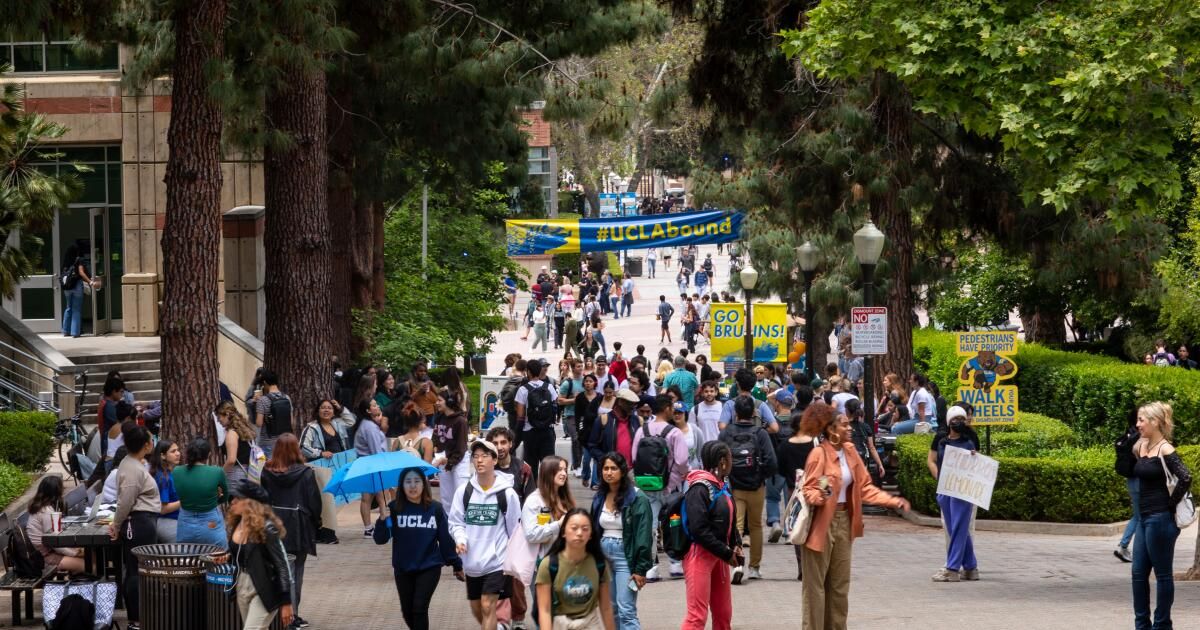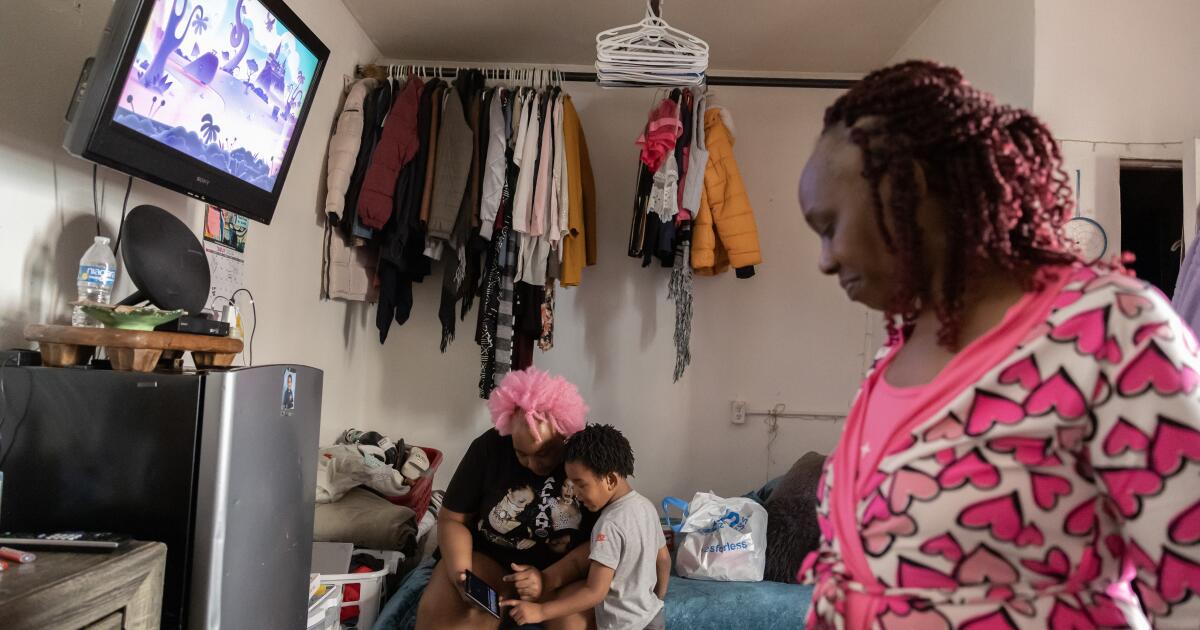The University of California admitted its largest and most diverse class of undergraduates for fall 2024, opening the doors of the acclaimed public research institution to more low-income, first-generation and underrepresented California students of color, according to preliminary data released Wednesday.
In a surprising development, UC shared the gender identity of admitted students for the first time as part of its annual data release. Systemwide, women are the dominant gender among first-year students, reaching 55%. At six campuses (Berkeley, Davis, Irvine, UCLA, San Diego and Santa Barbara), the gender gap is larger, with men making up about 37% of students. UC Merced was the most balanced, with 49% women and 46% men. The genders were more even among transfer admits.
About 5% of admitted students identified differently (as nonbinary or transgender, for example) or did not disclose their gender identity.
Overall, UC admitted 93,920 California freshmen, up 4.3% from last year, an all-time high amid widespread public calls to give more seats to in-state students after campuses began admitting a higher share of international and out-of-state applicants several years ago to boost admissions amid major state funding cuts.
The systemwide admission rate for California freshmen rose to 70% from 68% last year. But at UCLA, the nation's top college, the admission rate remained in the single digits, at 9.5%. In all, UC offered admission to 166,706 freshmen and transfer students from California and other states and countries.
For the fifth consecutive year, Latinos were the largest group of freshmen admitted to California, largely because they are the most accepted at UC Merced. At the other eight undergraduate campuses, Asian Americans were the leading admissions group. Overall, Latinos accounted for 39% of freshmen admitted to California, followed by Asian Americans at 33%, whites at 18%, black students at 6%, American Indians at 1% and Pacific Islanders at less than 1%.
UC also increased access to low-income students, who accounted for nearly 41% of California's admitted freshman class; the share of those who will be first in their families rose to 43%.
The university system also made notable progress in expanding access to California Community College transfer applicants, offering admission to 26,430, a 7.8% increase over last year. The higher admissions numbers reflect an uptick in transfer applicants after a pandemic-driven decline. UC received 34,668 transfer applications for fall 2024, up from 31,646 last year. About 3 in 4 applicants were admitted.
“These admissions numbers demonstrate the University of California’s commitment to expanding opportunity and access, especially for historically underrepresented groups, who make up the largest share of first-year students in history,” said UC President Michael V. Drake. “We are putting more California students on a path to a college degree and future success, and that translates to a positive impact on communities across the state.”
The FAFSA fiasco
This year’s admissions cycle was complicated by a major fiasco: the flawed implementation of a new federal financial aid form that led to significant delays in submitting, receiving and processing student information to assess financial aid eligibility. Campuses are still unsure how many admitted students will ultimately enroll because hundreds have yet to submit their Free Application for Student Aid, known as the FAFSA.
“The FAFSA crisis is overshadowing and overshadowing everything,” said Jim Rawlins, associate vice chancellor for enrollment management at UC San Diego. “This is what keeps me up at night.”
Rawlins said as many as 400 students who accepted San Diego’s offer of admission have yet to file a FAFSA — a 60% increase from last year — which could lead many to abandon their plans to attend because they didn’t file the form and didn’t receive financial aid. She said her staff is doing everything it can to reach out to those students to help them, but the federal Department of Education hasn’t fully resolved all the issues: It sent out a notice Tuesday saying schools won’t be able to send out batches of application corrections this cycle.
That uncertainty, Rawlins said, was one reason San Diego increased admissions offers this year, accepting 22,979 first-year applicants from California compared with 20,800 last year. But the campus also hopes to add a few hundred more seats, as part of a systemwide commitment to add 2,927 California students in 2024-25. UC plans to follow through on expansion plans despite receiving $124 million less than expected under the five-year agreement with Gov. Gavin Newsom and the Legislature because of the state budget shortfall.
UCLA Admissions Set It Apart
UCLA offered admission to 8,795 first-year applicants from California for fall 2024, an increase of about 200 students from last year. That was the smallest number of offers among UC campuses. But UCLA doesn’t need to admit as many students as other campuses to meet its enrollment goals because its acceptance rate is high, about 60%, said Gary Clark, UCLA’s associate vice chancellor for enrollment management. UCLA also admitted 5,518 transfer applicants for fall 2024. The campus expects to enroll about 5,250 first-year students and 3,400 transfer students.
For applicants who may consider UCLA a near-impossible choice, with a weighted GPA of 4.58, the transfer route is generally more accessible, with an overall admission rate of 26%. But Clark said students should be aware of the wide variation among majors: The transfer admission rate for computer science is 5%, for example, compared with 60% or more for history, linguistics and philosophy.
Clark also reiterated that UCLA considers grades and academic records in the context of the opportunities available to an applicant. A student who attends a high school without the full offering of Advanced Placement courses will not be compared to someone from a more resourceful school.
The Westwood campus had the most offers to black students, who accounted for 8% of all first-year applicants admitted in California. UC Merced had the highest share of offers to Latinos (45%), while Asian Americans accounted for at least 40% of students admitted to Irvine, Berkeley, Davis and Riverside.
Overall, UC Riverside admitted the largest number of freshmen and transfer students in California (43,016, up from 39,139 last year) and is one of the UC campuses with room to grow significantly. Riverside also accepted the largest number of low-income students and the first in their families to attend college.
“We really want to make sure that UCR is accessible to our California residents,” said Veronica Zendejas, director of undergraduate admissions.
UC Santa Cruz admits majority of non-binary students
At UC Santa Cruz, the biggest news is the solid growth in the number of transfer students the campus plans to enroll. Santa Cruz increased freshman admissions across the board, including 35,008 Californians and 11,574 nonresidents. But Santa Cruz plans to use most of its state funding to increase transfer student enrollment by 19%, said Michelle Whittingham, associate vice chancellor for enrollment management.
Whittingham also said transfer students who meet unit, GPA and major readiness requirements have an excellent chance of being accepted. “There’s a lot of narrative about how hard it is to get into UC, but if you meet the criteria we put out there, you’re in” for most majors, he said.
UC Santa Cruz is also the preferred campus for students who identify as a gender other than female or male.
Across UC’s nine undergraduate campuses, 1,453 first-year applicants from California identified as nonbinary; 683 of them were admitted to UC Santa Cruz. One trans applicant drove three hours from Washington state to a UC Santa Cruz recruiting event in Oregon because the campus was their first choice given its reputation for inclusion and support of LGBTQ+ people, Whittingham said.
More offers for California applicants
UC Davis has also stepped up its outreach to transfer applicants, expanding its work with community colleges, said Malisa Lee, vice chancellor for enrollment management. Overall, the campus increased admission offers by 4.2 percent to Californians from 57 of the state’s 58 counties.
UC Berkeley reduced admission offers to all categories of first-year applicants, especially international students, which decreased to 751 for fall 2024, compared with 1,129 last year. Offers to California transfer applicants increased by about 140.
In contrast, UC Irvine significantly increased its admission of international first-year applicants by 33% to 8,360 applicants for fall 2024, up from 6,260 last year, with a smaller 8.4% increase for California students. Irvine had the highest share of international students in its admitted class (24%) and the lowest share of Californians (54%).
UC Santa Barbara increased offers to California students by 15.7%, out-of-state students by 11.5% and international students by 36%.
UC Merced also admitted more first-year students overall, and led all campuses in the share of Californians who are underrepresented students of color, with 53% of them of Latino, Black, Native American and Pacific Islander descent.












